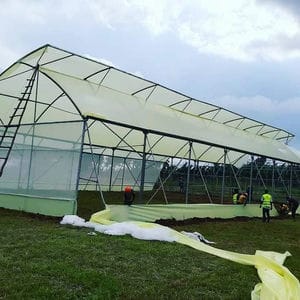Method of greenhouse Soil sterilization in Kenya
Method of greenhouse Soil sterilization in Kenya. Soil science helps us understand its aspect be it the biological, physical, or chemical composition of plants or vegetable production in greenhouses and open-field farming.
We do soil testing to understand the microbes living in the soil, we do have helpful and harmful.
Method of greenhouse Soil sterilization in Kenya.
Steaming
Soil sterilization is an essential process for greenhouse farming in Kenya, and one of the most effective ways to do it is by using steam. This method can kill a wide range of soil-borne pathogens and weed seeds, leading to healthier crops and higher yields. Here's a step-by-step guide on how to sterilize soil using steam:
Step 1: Prepare the soil
Clear the soil of any debris, including rocks, plant residues, and weeds. The soil should be dry enough to conduct heat effectively.
Step 2: Moisturize the soil
Add enough water to the soil to make it moist, but not waterlogged. The moisture level should be sufficient to conduct heat effectively.
Step 3: Install the steam generator
Install the steam generator in your greenhouse and connect it to a power source. Fill the generator with water and turn it on to start producing steam.
Step 4: Insert the steam wand
Insert the steam wand into the soil at a depth of at least 30cm (12 inches). Move the wand slowly through the soil to ensure even steam distribution.
Step 5: Maintain the temperature
Keep the soil temperature at 70°C (158°F) or higher for at least 30 minutes. The temperature may need to be adjusted depending on the type of soil and the pathogens present.
Step 6: Cool down the soil
Allow the soil to cool down before planting. Use a thermometer to ensure that the soil temperature is suitable for your crops.
By following these steps, you can effectively sterilize your greenhouse soil using steam. This method is safe, environmentally friendly, and can help to increase your crop yield by eliminating harmful pathogens and weed seeds.
Soil sterilization using steaming is the most reliable way since we retain the chemical composition and the physical structure of the soil. This is done by using heated water steam that is directed in air-tight covered soil and it takes eight hours to be fully sterilized.
Frying.
This method uses dry heat to kill soil-borne pathogens and weed seeds, leading to a healthier and more productive crop. Here's a step-by-step guide on how to sterilize soil using the frying method:
Clear the soil of any debris, including rocks, plant residues, and weeds. The soil should be dry enough to conduct heat effectively.
Step 2: Cover the soil
Cover the soil with a clear plastic sheet or greenhouse film. The plastic should be tightly sealed to prevent any heat from escaping.
Step 3: Apply heat
Use a heat source such as a gas burner or electric hotplate to heat the soil to at least 90°C (194°F). Maintain the temperature for at least 30 minutes to ensure effective sterilization.
Step 4: Cool down the soil
Allow the soil to cool down before planting. It's important to ensure that the soil temperature is suitable for your crops before planting.
The frying method is an effective way to sterilize greenhouse soil in Kenya. It's cost-effective, easy to implement, and can help prevent diseases and pests that can damage crops and reduce yields. By following these steps, you can ensure that your greenhouse soil is free of harmful pathogens and weed seeds, leading to a successful and healthy harvest.Soil frying is also another common way people use in sterilization, it also does kill the pathogen the only disadvantage it has is the change of chemical and physical properties of the soil. the methodology is done by putting soils in a pan and placing the pan on heat, during heating the soil is mixed over and over for uniform distribution of heat.
Chemicals
This method involves using chemicals to kill soil-borne pathogens and weed seeds, leading to a healthy and productive crop. Here's a step-by-step guide on how to sterilize soil using chemical methods:
Step 1: Prepare the soil
Clear the soil of any debris, including rocks, plant residues, and weeds. The soil should be dry enough to conduct heat effectively.
Step 2: Choose a chemical sterilant
Choose a chemical sterilant that is approved for use in greenhouse farming in Kenya. Some commonly used chemicals include methyl bromide, chloropicrin, and sodium azide.
Step 3: Apply the sterilant
Follow the manufacturer's instructions to apply the sterilant to the soil. The amount and application method may vary depending on the type of sterilant used.
Step 4: Cover the soil
Cover the soil with a clear plastic sheet or greenhouse film. The plastic should be tightly sealed to prevent any chemical fumes from escaping.
Step 5: Wait and ventilate
Wait for the recommended time for the chemical to take effect. Once the recommended time has passed, ventilate the greenhouse to ensure that all chemical fumes are removed.
Step 6: Check the soil
Use a soil testing kit to check the soil's pH level and ensure that it's suitable for planting.
Chemical sterilization is an effective way to sterilize greenhouse soil in Kenya, but it should be used with caution. Follow all safety precautions and use only approved chemicals for greenhouse farming.
By following these steps, you can ensure that your greenhouse soil is free of harmful pathogens and weed seeds, leading to a successful and healthy harvest.
Chemicals are also used to do soil sterilization mostly in flower farms, for vegetables and fruits we tend to discourage this method. When not done properly it can leave residue on the final product. Greenhouse and Irrigation Solutions for Kenya



.png)


 20%
20%


